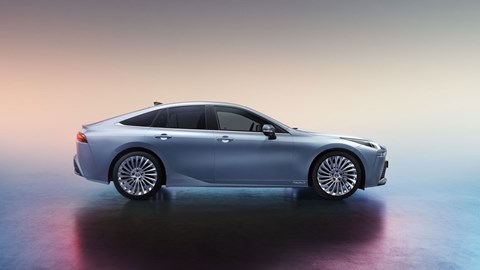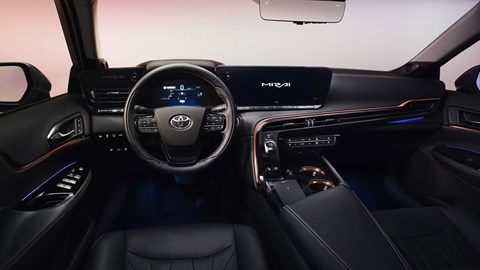► Revealed ahead of Tokyo motor show
► Slicker looks, boosted fuel-cell tech
► Engineers targeting 30% range increase
Remember the Mirai, Toyota’s look into an alternate future where it’s hydrogen power – not battery power – that leads the sustainable charge? Here’s another look at the second one, first shown at the Tokyo motor show, and now making its European debut.
The model pictured is near-production, so should look pretty much the same when it’s released in Japan, North America and Europe later this year.
It looks good?
Toyota has sold around 10,000 previous generation Mirais, but it hopes the new car’s looks will inspire more customers to open their wallets. To our eyes, the new Mirai is a fresh, premium departure from the oddball looks of the last car. The 20-inch alloys certainly help, too.

Featuring low slung lines, a chunky wedge side profile, and grille that’s just the right size, the new Mirai looks more GT or premium saloon than ‘strange gassy experiment.’
‘We have pursued the goal of making a car that customers will feel they want to drive all time, a car that has an emotional and attractive design and the kind of dynamic and responsive performance that can bring a smile to the driver’s face,’ said Yoshikazu Tanaka, the new Mirai’s chief engineer.
‘I want customers to say “I chose the Mirai not just because it’s an FCEV, but because I simply wanted this car; it just happens to be an FCEV.” We will continue our development work focusing on that feeling, and we hope that with the new Mirai we will be a leader in helping realise a hydrogen energy society.’

Inside you’ll find a 12.3-inch infotainment screen along with five seats over the current car’s four. That’s down to better, more efficient packaging of the new Mirai’s fuel cell system.
And just how far can it go?
Toyota is targeting a 30% increase in driving range over the current car, so expect a total range of something like 400 miles. Engineers have also focused on improving the response and driver controls compared to the old car, too.

We’ll update this article when we know more.